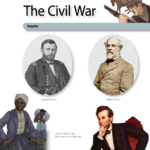Learn about Black history in the United States before and after the Civil War; the Civil Rights Movement; the history of Africa; African American art; and African American trailblazers.
Women’s Contributions in the Civil War
In this lesson, students will view videos to visit Civil War-related sites in Alexandria, Va., where women worked as nurses, sold goods to soldiers and aided communities of newly-freed slaves.
Women & the American Story: A Nation Divided, 1832-1877
This free curriculum unit from the New-York Historical Society delves into the ways women participated in all aspects of the Civil War and on both sides of the conflict, from the early debate over the expansion of slavery through the end of federal Reconstruction. Materials examine this pivotal moment in American history through the experiences of diverse women and consider how the war and then Reconstruction policies shaped their lives.
1968: The Poor People’s Campaign
1968 was a tumultuous period in the United States. The Vietnam War, political assassinations and civil rights issues were among some of the challenges the country faced as solutions were sought. At this time, Martin Luther King Jr. organized the Poor People’s Campaign to shift the focus of the civil rights movement to economic issues; however, Reverend King was assassinated weeks before the campaign got underway in Washington, D.C. In this lesson, students will learn about the circumstances that gave rise to this campaign and how it is relevant today.
When National Security Trumps Individual Rights
On December 18, 1944, the U.S. Supreme Court handed down one of its most controversial decisions when it upheld the government’s decision to intern all persons of Japanese ancestry (both alien and nonalien) on the grounds of national security. Over two-thirds of the Japanese in America were citizens and the internment took away their constitutional rights. In this lesson, students evaluate the consequences of past events and decisions related to the Supreme Court case Korematsu v. United States (1944). They consider the challenges involved when trying to balance civil liberties and national security during threatening times and reflect on the lessons learned about civil liberties from the justices in the Korematsu case.
Juneteenth General Order
In this activity, students will carefully analyze General Order 3 from Major General Gordon Granger which informed the people of Texas that “all slaves are free.” This activity is appropriate as a conclusion to the Civil War and the beginning of Reconstruction.
The Civil War (CKHG Unit)

This unit explores the political, historical and cultural causes and consequences before, during and after the Civil War, one of our nation’s greatest crises. Across 24 lessons, students engage with the material through primary sources and consider the influence of abolitionists and other intellectual as well as military and political figures.
This unit includes 24 lessons that are about 45 minutes each.
The Civil War and Reconstruction
Why was the Civil War fought? How did Reconstruction change the relationship between the federal government, the states and the people? This video lecture explores these questions. It’s part of an online course taught by University of Pennsylvania law professor Kermit Roosevelt III. “Introduction to Key Constitutional Concepts and Supreme Court Cases” covers the topics: Where does the Constitution come from? How has it changed over the years? How do we know what it means?
Reconstruction and Citizenship
Historian Eric Foner, of Columbia University, discusses the major changes in citizenship during and after the Civil War, particularly for African Americans.
Iroquois Council: Choosing Sides
In this simulation, elementary or middle school students convene as an Iroquois council in upstate New York, 1777. British agents are trying to convince Iroquois nations to take their side in the Revolutionary War.